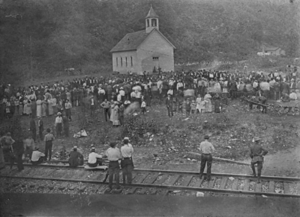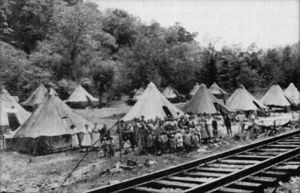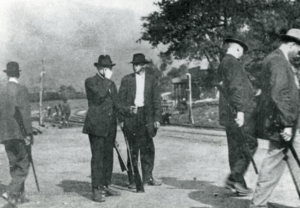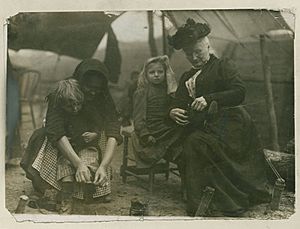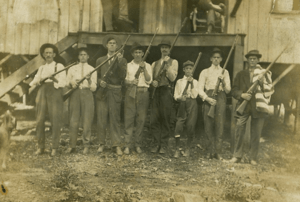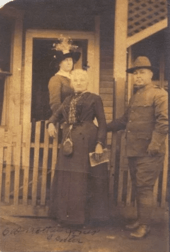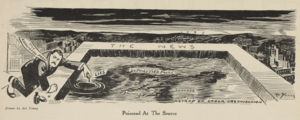Paint Creek–Cabin Creek strike of 1912 facts for kids
Quick facts for kids Paint Creek–Cabin Creek strike |
|||
|---|---|---|---|
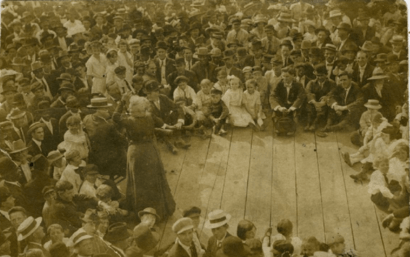
Labor organizer Mother Jones rallying workers in the town of Montgomery in August 1912.
|
|||
| Date | April 18, 1912 – July 1913. | ||
| Location | |||
| Goals | Union recognition | ||
| Methods | Strikes, Protest, Demonstrations | ||
| Parties to the civil conflict | |||
|
|||
| Lead figures | |||
|
|||
| Arrests, etc | |||
|
|||
The Paint Creek–Cabin Creek Strike was a big fight between coal miners and coal companies in Kanawha County, West Virginia. It happened near two streams, Paint Creek and Cabin Creek. This important strike lasted from April 1912 to July 1913.
It was one of the worst conflicts in American labor history. Many people died, not just from the fighting, but also from hunger. This strike was a big event that led to other important labor conflicts in West Virginia, like the Battle of Matewan and the Battle of Blair Mountain.
Contents
Why Miners Went on Strike
The trouble on Paint Creek and Cabin Creek started with a United Mine Workers of America (UMWA) strike. This happened in April 1912. Before the strike, there were 96 coal mines in the area. About 7,500 miners worked there.
The mines on Paint Creek were part of the union. However, these miners were paid less than other union miners nearby. They earned 2½¢ less per ton of coal.
When the union talked about a new contract in 1912, they asked for equal pay. This would have cost the companies only about fifteen cents more per miner each day. But the coal companies said no. So, the union called for a strike on April 18, 1912.
The miners had several important demands:
- They wanted the companies to accept and recognize their union.
- They wanted their right to speak freely and gather peacefully.
- They wanted companies to stop "black-listing" workers. This meant stopping companies from secretly sharing lists of fired workers to prevent them from getting new jobs.
- They wanted to stop being forced to buy things at company stores.
- They wanted fair weighing of coal. They wanted 2,000 pounds of coal to be a ton. They also wanted scales at the mines to weigh the coal.
- They wanted to hire their own "check-weighmen." These people would check the weights found by the company's weighmen. This was allowed by law.
- They wanted both check-weighmen to decide any penalties for coal that wasn't mined correctly.
After some discussion, the miners on Cabin Creek decided to join the strike too.
The Conflict Begins
When the strike began, the national United Mine Workers union offered full support. They hoped to help the union grow in Southern West Virginia. The union promised money and help to the striking miners.
For the first month, the strike was peaceful. But on May 10, 1912, the coal companies hired the Baldwin–Felts Detective Agency. This agency was known for breaking strikes. Over 300 mine guards arrived, led by Albert Felts, Lee Felts, and Tony Gaujot.
A famous labor activist named Mother Jones arrived in June. The mine owners started kicking workers out of their homes. They also brought in new workers to replace the strikers. Beatings, sniper attacks, and damage to property happened every day.
Through July, Mother Jones encouraged the workers. She even got past armed guards to convince other miners in Eskdale, West Virginia to join the strike. She also organized a secret march of three thousand armed miners. They marched to the state capitol in Charleston. There, they read a "declaration of war" to Governor William E. Glasscock. On July 26, miners attacked a town called Mucklow (now Gallagher). At least twelve strikers and four guards died.
Escalation and Martial Law
On September 1, more than 5,000 miners from another area joined the strikers. They set up a tent city. Because of this, Governor Glasscock declared "martial law" the next day. This meant the military took control of the area.
About 1,200 state troops took away weapons from both sides. This helped calm things down a bit. But strikers were not allowed to gather in groups. They also faced quick, unfair trials in military court. Meanwhile, the families of the strikers began to suffer. They were hungry, cold, and lived in unhealthy conditions in their temporary tent colony at Holly Grove. Mother Jones and another activist, Ma Blizzard, organized an "umbrella march." Pro-union women marched through the valley holding umbrellas.
On October 15, martial law was lifted. But it was put back in place on November 15. Then it was lifted again on January 10 by Governor Glasscock. He had less than two months left in office. On February 7, Mucklow was attacked again by miners. At least one person was hurt.
In response, that evening, the Kanawha County Sheriff Bonner Hill and some detectives attacked the Holly Grove miners' settlement. They used an armored train called the "Bull Moose Special." They fired machine guns and powerful rifles. They shot 100 machine-gun bullets into the home of striker Cesco Estep, killing him. Sarah Blizzard led a group of women to damage the railroad tracks. This stopped the train from attacking again. A few days later, another miner raid on Mucklow killed at least two people. On February 10, martial law was put in place for the third and final time.
Mother Jones was arrested on February 13 in Pratt. She was charged in military court for causing trouble. She was also accused of planning serious crimes. She refused to accept the military court's authority. She would not enter a plea. Jones was sentenced to twenty years in prison. She also got sick with pneumonia.
Resolution and Aftermath
New governor Dr. Henry D. Hatfield took office on March 4. His first priority was to visit the area. He released about thirty people held under martial law. He also moved Mother Jones to Charleston for medical care. In April, he set conditions for ending the strike. Strikers had to accept Hatfield's terms, or they would be forced to leave the state. The Paint Creek miners accepted and signed the "Hatfield Contract" on May 1. The Cabin Creek miners continued to fight, with some violence, until the end of July.
Mother Jones remained under house arrest for a while. She was staying at Mrs. Carney's Boarding House. She managed to send a secret message out through a hidden trapdoor in her room. This message went to a pro-labor Senator named John Worth Kern in Indiana. Governor Hatfield released Jones without saying why. She had been held for 85 days.
Senator Kern's actions led to a big investigation. The United States Senate's Committee on Education and Labor looked into the conditions in West Virginia coal mines. Congress soon started similar investigations into copper mining in Michigan and mining in Colorado.
One goal of the Senate hearings was to find out how many people died in the strike. They also wanted to know who was responsible. Some estimates say "perhaps fifty violent deaths" occurred. This does not even count the deaths caused by the harsh conditions in the tent camps.
The strike gained national attention in July 1913. A cartoonist named Art Young drew a cartoon called "Poisoned at the Source." It showed the president of The Associated Press, Frank B. Noyes, putting lies and bad information into a well labeled 'The News.' An article by Max Eastman said that the Associated Press had hidden facts about the strike. It also said the Associated Press had a conflict of interest. The local Associated Press representative, Cal Young, was also part of the military court that judged the strikers. The Associated Press sued Eastman and Young, but both lawsuits were eventually dropped.
The United Mine Workers of America, Mother Jones, and the Baldwin-Felts Detectives were all involved in another big conflict. This was the Colorado Coalfield War. It started as a strike in September 1913 against the Rockefeller-owned Colorado Fuel and Iron company. This conflict included the terrible Ludlow Massacre on April 20, 1914.


